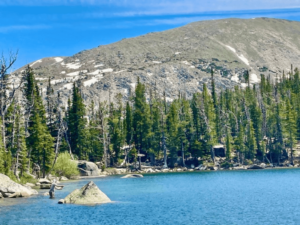 Cold water touches my feet, wrapped up securely in my Chacos as I travel through the Tobacco Root Mountain Range with the Wild Rockies Field Institute’s (WRFI) semester course, “Conservation Across Boundaries.” The water has a bluish-green tint, and is so calm the surface looks like glass. The wind occasionally disrupts the flat water, adding ripples that slowly push into the bank. The hilltop to the north is filled with beetle-killed Whitebark Pine trees with only occasional green, sturdy, living conifers in the mix. To the west, Potosi Peak towers over the water. A splash sends my attention back to the water: a fish has emerged.
Cold water touches my feet, wrapped up securely in my Chacos as I travel through the Tobacco Root Mountain Range with the Wild Rockies Field Institute’s (WRFI) semester course, “Conservation Across Boundaries.” The water has a bluish-green tint, and is so calm the surface looks like glass. The wind occasionally disrupts the flat water, adding ripples that slowly push into the bank. The hilltop to the north is filled with beetle-killed Whitebark Pine trees with only occasional green, sturdy, living conifers in the mix. To the west, Potosi Peak towers over the water. A splash sends my attention back to the water: a fish has emerged.
I cast my large brown stonefly pattern fly towards the direction of several trout cruising the shallow waters of the lake. After a few strips of my line, I feel a tug and the fight has started. Stripping the fish in by hand, I am surprised to see the coloration of the fish. The recognizable red, green, and silver of a non-native Rainbow Trout. What was this exotic species doing in a remote location of the Tobacco Root Mountains in Montana?
Working towards my degree in fish and wildlife management at Montana State University, I wanted to take this semester course, Conservation Across Boundaries, in order to broaden my horizon on conservation tactics and management issues. In school, I have had countless lectures and discussions about another fish, red, green, and gold with an apparent “cut throat” from a vibrant red or orange slash below the jaw: the Yellowstone Cutthroat Trout, native to this section of Montana. This native fish has spent thousands of years adapting and evolving its physical characteristics to successfully live in these waters. They are culturally important for Indigenous people and serve as a major food source for other species. Now it is on the verge of collapse. Encroachment of invaders such as the Rainbow Trout have pushed the native species to the brink. I was shocked to see the non-native species here.
Looking down at my catch, I think about how “encroachment” is not often a word associated with Rainbow Trout. Instead, encroachment is reserved for other, more contentious species in the Greater Yellowstone Ecosystem–species like the Gray Wolf. Reintroduced in 1995, the Gray Wolf has made public headlines for the Yellowstone community for over 25 years. Many ranchers have been concerned for the safety of their livestock and livelihoods. Hunters are frightened that the substantial elk populations of southern Montana will be virtually eliminated from wolf predation. The animal that once called this area home before the rapid extermination of the species is once again “encroaching” into communities that depend on this ecosystem for survival. The result: wolves are often hunted, trapped, poisoned, and driven out of their native range.
Learning more about the challenges these carnivores face during our WRFI class discussions have made me wonder why large carnivorous species are so villainized. The wolf has proven to be a keystone species in the Yellowstone area. Wolves’ predation on elk have reduced artificially high elk populations within the Greater Yellowstone Ecosystem and has allowed the elk’s food source, aspens and willows, to regrow–a prime example of a trophic cascade. Their reintroduction has created a more resistant and resilient ecosystem. On the other hand, the Rainbow Trout, although it seems like a non-threatening intruder, has reduced biodiversity, disrupted food webs, and lowered resilience in hundreds if not thousands of lakes, streams, and reservoirs within the same habitat as the Gray Wolf. The drastic difference in management of Gray Wolves and Rainbow Trout show that their presence on the landscape is dependent on human values and interests, not the health of the ecosystem.
Humans dictate the species they want on the landscape, and which they do not. Large charismatic species are often prioritized over smaller species such as the Yellowstone Cutthroat Trout, causing management tactics to be skewed within a single ecosystem. Taking a closer look at these species made me understand that every management decision has a profound and cascading effect over any ecosystem.
Over and over again, we see that humans are unable to adapt to the ecosystems that we choose to inhabit, and must constantly change them to be closer to our minds’ “ideal” landscapes. Humans introduce accessible fish to recreate and consume while pushing native fish to the brink. This is a change to the ecosystem to benefit us. We eliminate wolves from their natural lands to continue a large population of elk that we want. We take and take from the land with little regard to the consequences. Can humans learn to adapt with the earth and learn to change our mindsets to protect native ecosystems for generations to come? Or will we see the demise of interconnected and intact ecosystems that future generations will only be able to experience from natural history books in an ecologically changed world?